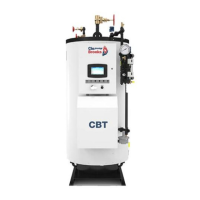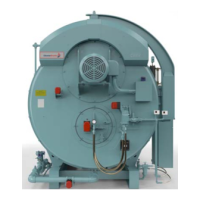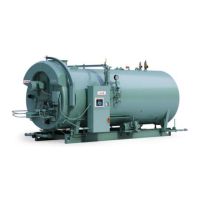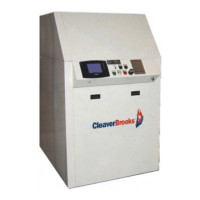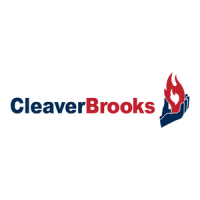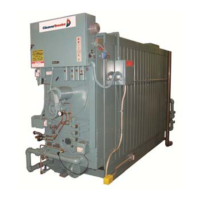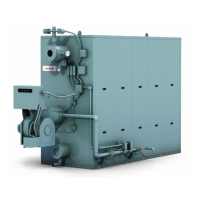Adjustment Procedures
6-24
750-91 (revised 2009)
Model CB-LE Packaged Boiler Manual
The O
2
levels through the entire firing range of the burner, low-fire to high-fire should be tested. The burner man-
ufacturer’s recommendations on turndown should also be followed and the turndown range of the burner should
not be exceeded.
It is required to set the burner to operate with a reasonable amount of excess air to compensate for minor varia-
tions in the pressure, temperature, or burning properties of oil. 15% to 20% excess air is considered reasonable.
This would result in an O
2
reading of 3% to 4% at high-fire.
Final adjustment to fuel input must be made to produce a minimum of smoke. A maximum smoke spot density of
a No. 2 for light oil, or a No. 4 for heavy oil is acceptable, as measured in conformance to ASTMD 2156-63T.
Through the use of the manual flame control, slowly bring the unit to high-fire by stages while monitoring com-
bustion for overly rich or lean conditions. At the high-fire position, the air damper should be fully opened and the
air and oil pressure readings should be on the order of the readings given in Chapter 5.
Take a flue gas analysis reading. If necessary, adjust the fuel oil controller to increase or decrease oil pressure.
Adjustments to the pressure should be done before attempting to adjust the screws in the metering cam. Ideally,
the cam profile spring should be as close to the cam casting as practical. It is more desirable to lower the oil pres-
sure to reduce flow, if necessary, than to extend the adjusting screws to an extreme position in an effort to cut back
flow.
After being certain that the air control damper and its linkage are operating properly, final adjustment can be made,
if necessary, to the oil modulating cam to obtain a constant air/fuel ratio through the entire firing range.
Since the input of combustion air is ordinarily fixed at any given point in the modulating cycle, the flue gas reading
is determined by varying the input of fuel at that setting. The adjustment is made to the metering cam by means of
adjusting screws, which are turned out (counterclockwise from the hex-socket end) to increase the flow of fuel and
in (clockwise from the hex-socket end) to decrease it. Flow rate is highest when the cam follower assembly is clos-
est to the jackshaft.
If oil pressure, primary air pressure, and linkages are properly adjusted, the metering cam should require minimal
adjustment.
Using the flame control switch, position the cam so that the adjusting screw adjacent to the end, high-fire screw,
contacts the cam follower. Make a combustion analysis at this point.
If an adjustment is necessary, turn the adjustment screw accordingly to increase or decrease fuel flow. Take a com-
bustion reading to verify input. Repeat as necessary until the desired flow is obtained. Continue this pressure, stop-
ping at each adjusting screw, until the low-fire position is reached.
NOTE: Be sure to loosen the cam foot locking screws before adjusting any cam screws or teh cam feet may be dam-
aged.
NOTE: Do not use any lubricant on the adjusting setscrews. These have a nylon locking insert intended to provide
locking torque and resistance to loosening and a lubricant could damage the equipment.
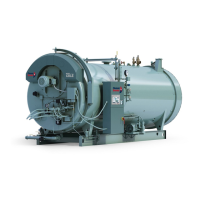
